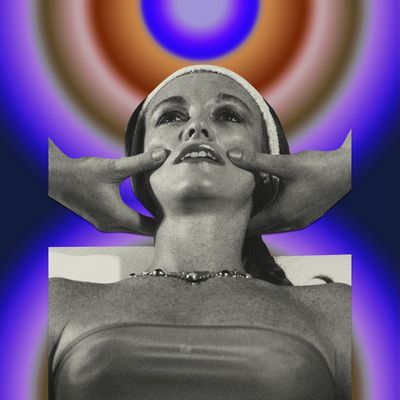
Photo-Illustration: by The Cut; Photo: Getty Images
A Facial Massage Inquiry:
Dear Beauty Editor,
Can facial massage change the shape of your face? I’ve seen videos of people who said it’s the reason their nose looks smaller or that it made their eyebrows tilt upward. How does it work?
Thanks,
Sofia
I know the type of videos you’re talking about, and many of them (this Eurocentric nose tutorial comes to mind) leave viewers with the impression that they can change their appearance by kneading their features into place — as if the complex arrangement of bone, muscle, and connective tissue beneath their skin is no different than Play-Doh. To be fair, there are positive benefits of facial massage. But if you’re thinking about making it part of your beauty routine, “Realistic expectations and an understanding of anatomy are super important,” says aesthetician Raquel Medina-Cleghorn, founder of Raquel New York. Facial massage cannot change your bone structure, tighten your skin, or replace volume (e.g., plump up sagging cheeks or fill under-eye hollows). What it can do goes hand in hand with how it works.
Massage is any technique that manipulates muscles, whether that’s done with a tool (like a warm stone or face roller), fingers (yours or someone else’s), or specific exercises (think face yoga). All these modalities have similar benefits: They strengthen and/or release tension from muscles, increase blood circulation, and stimulate the movement of fluid. “Encouraging lymph drainage is where I think people see the most immediate result of facial massage,” says aesthetician Ian Michael Crumm. “It’s not, ‘Oh, gosh, I massaged my face two times and my muscles have transformed!’ It’s, ‘Oh, I was looking a little puffy, and now the fluid has moved and you can see the muscle contours a little bit better.”
Massage may also boost blood circulation, which is a net positive because it helps to deliver oxygen and nutrients to your skin cells so they’re performing at their optimal levels. This won’t dramatically affect your appearance — your cells are getting oxygen and nutrients even if you don’t massage — but it’s generally a good thing. Plus, it can temporarily brighten your skin tone and make you look refreshed and more awake (pinch your cheeks or do some burpees and you’ll see what I mean).
Where the results of facial manipulation get trickier are at the muscular level. Let’s say you hold a lot of tension in your jaw or grind your teeth at night. Your masseter muscles may be overdeveloped, which could bulk up the appearance of your lower face. If you work on releasing that tension and relaxing those muscles with massage or exercises, “The result can be a slimmer or more refined appearance,” says Medina-Cleghorn. But to see long-term changes, you’d need to continue … for the long term. “The results will be cumulative, but if the practice stops, the results will fade away,” she says. It’s also worth noting that the muscles controlling movement and affecting the appearance of the two areas you mentioned — your nose and eyebrows — would be difficult to isolate and work on with massage or exercise.
That’s why I think of massage as a holistic practice with generally positive results rather than a targeted technique for changing specific aspects of your appearance. With a similar mind-set, you don’t need to get hung up on learning specific techniques, snagging an appointment with an in-demand facialist, or sticking to a schedule. Just add some movement to your usual skin-care routine. “Use light-to-medium pressure, a high-quality face oil for glide, and avoid working over any inflamed or irritated areas,” says Medina-Cleghorn. As for the direction of your massage, “A good rule of thumb is upward and outward,” says Crumm. Not because you’re trying to train your face in that direction! It just helps to move along lymph and generally de-puff you. (If you can make that a regular habit and want to step things up, Medina-Cleghorn suggests checking out the self-massage and acupressure techniques in @noyskincare’s videos.)
And if you happen to scroll past a video that makes you think that you’re doing things incorrectly, don’t worry. The goal of the simplest massage practice is to get things moving. “Flow equals life and stagnation equals death — that sounds really dramatic, but it’s true,” says Medina-Cleghorn. “We want our connective tissue to be flexible and we want fluids to be moving. Tight muscles mean reduced blood flow and stagnant lymph, and the movement of these fluids is essential for health and vitality.” And wouldn’t you rather have health and vitality than a smaller nose and eyebrows that tilt upward?
Send your questions to [email protected]. (By emailing, you agree to the terms here.)
More Beauty Advice
How Bad Is It to Brush Wet Hair, Really?
What Is Lip-Blushing?
Tags:
- style
- beauty
- ask a beauty editor
- shopping
Show Leave a Comment
Can a Massage Really Change Your Face Shape?
Adblock test (Why?)



































































































